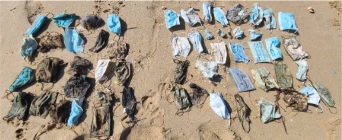By Jorge Casuso
August 2021 – According to data from Heal The Bay’s Coastal Cleanups, more masks and gloves were removed from the beaches of Santa Monica Bay in the past year than common items like glass bottles.
In July 2020, the Santa Monica-based nonprofit began tracking “the effects of improper disposal” of personal protective equipment (PPE) – most of it single-use – on the Los Angeles County coast, Heal the Bay officials said.
| Face masks on the beach (Images courtesy of OceansAsia) |
Last year, volunteers removed 4,808 masks and gloves in LA County and an additional 27,530 masks and gloves from beaches, waterways and neighborhoods across the state.
“Through our data, we can clearly see the impact of the pandemic on our waste stream,” said Emely Garcia, senior manager of Heal the Bay’s Beach and Watershed programs.
“In the first year of tracking this item, PPE became one of the top 10 items found by our volunteers, outperforming common items like glass bottles,” said Garcia.
City officials report that the amount of trash collected by public works crews on Santa Monica beaches has decreased during the coronavirus lockdown but has increased again as stores reopened.
Public Works’ resource recovery and recycling (RRR) does not analyze the amount of PPE in the garbage, officials said.
The effects of the COVID-19 emergency and widespread regulations requiring the use of face masks are being recorded in the oceans around the world.
According to a December 2020 report by Hong Kong-based marine conservation group OceansAsia, nearly 1.56 billion face masks likely spilled into the world’s oceans last year.
The group’s report, titled Masks on the Beach: The Impact of COVID-19 on Marine Plastic Pollution, estimates that this will likely result in an additional 4,680 to 6,240 tons of plastic pollution in the ocean.
 |
“These masks will take up to 450 years to decompose, slowly turn into microplastic and at the same time negatively affect marine animals and ecosystems,” the report said.
The COVID-19 emergency has also sparked a change in daily behavior that has compounded plastic pollution, the report said.
“Hygiene concerns and an increased reliance on take-away have resulted in an increased use of plastics, especially plastic packaging,” said Gary Stokes, Director of Operations, OceansAsia.
“In the meantime, a number of measures to reduce plastic consumption, such as banning single-use plastic bags, have been delayed, paused or withdrawn,” said Stokes.
Ocean Conservancy officials, who published their own report in March, titled “Pandemic Pollution: The Rising Tide of Plastic,” echoed OceanAsia’s findings.
The shift to curb delivery and collection has increased dramatically in single-use plastic bags, food and beverage containers, and other single-use plastics, said Janis Searles Jones, CEO of Ocean Conservancy.
The group’s report analyzed items found in a cleanup where volunteers removed 107,219 PPE items from beaches and waterways around the world in the second half of 2020.
“The pandemic has dramatically increased the use of certain types of plastic products, particularly PPE,” Searles Jones wrote in the introduction to the report.
Items found and logged by the Ocean Conservancy cleanup volunteers included face masks, gloves, face shields and disinfectant wipes, according to the report.
Face masks made up 81 percent of the PPE items volunteers encountered, according to the report.
The Ocean Conservancy report cites researchers from the Center for Environmental and Marine Studies at Avero University in Portugal who estimated that 129 billion face masks and 65 billion gloves were used worldwide every month during the pandemic.
Rep. Richard Bloom, who has sponsored laws to curb plastic pollution in California’s oceans, said he was not surprised by the results.
“Over the past decade, plastic microfibers from clothing, skin care products and disposable wipes have been added to the ever-growing list of plastic pollution in our oceans,” said Bloom.
“Now PPE pollution is making things a lot worse,” said Bloom, a former Santa Monica mayor. “The microfibers in these products are known pollutants.
“Our protection with PPE and the protection of our environment do not have to be mutually exclusive,” he said. “If we do our part, we can protect ourselves and our environment during the pandemic.”
Heal the Bay is hosting a Coastal Cleanup on Saturday September 18th. For further information, click here


Comments are closed.